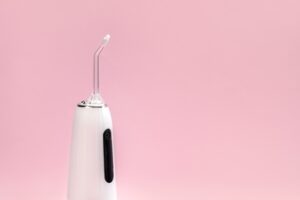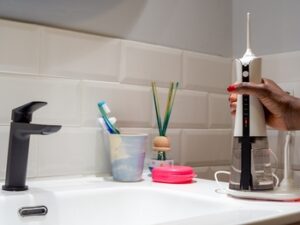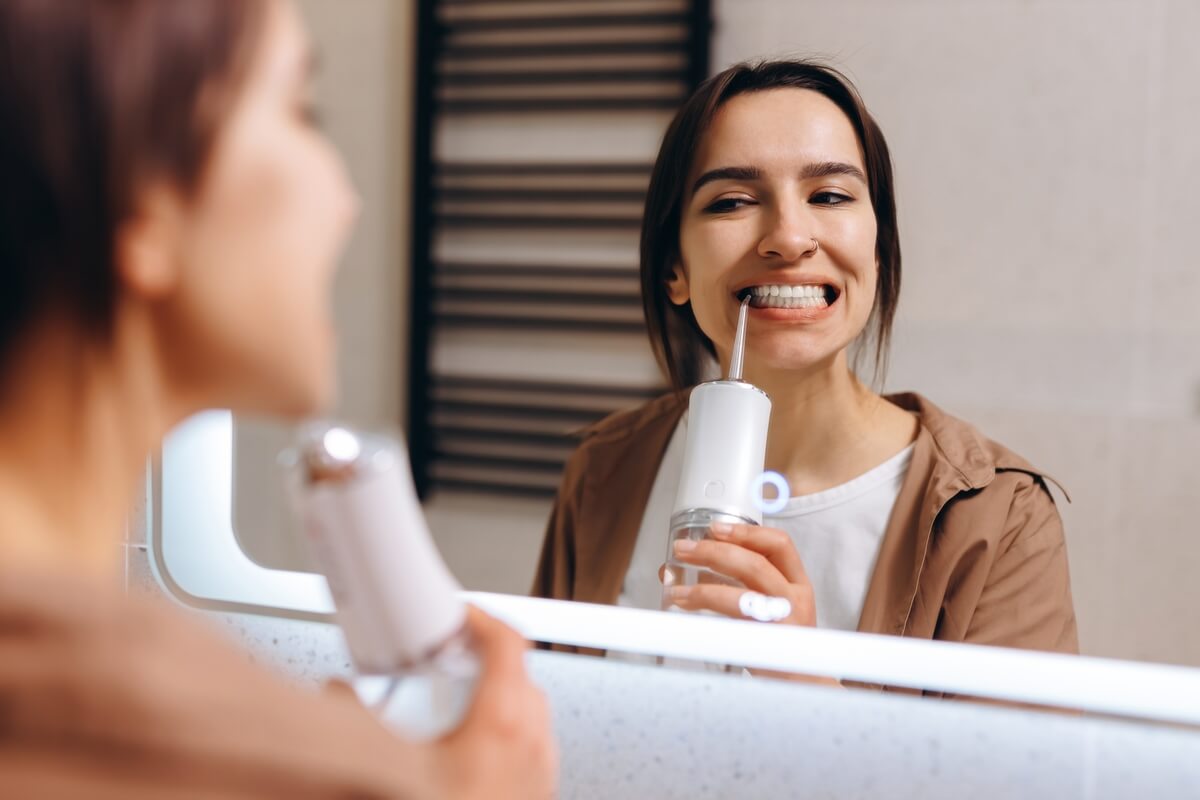Also known as oral irrigators, water flossers have gained popularity in recent years as a potentially more comfortable and effective alternative to traditional string flossing. These devices utilise a stream of pulsating water to clean between teeth and below the gum line, areas often difficult to reach with a toothbrush. But do dentists actually endorse the use of water flossers? This blog post will answer this question and explore the efficacy of water flossers in maintaining oral hygiene.
What Is a Water Flosser?
A water flosser is an electronic device used for maintaining oral health by assisting in the removal of food particles and dental plaque from between teeth and under the gumline.
 This innovative tool is seen as a more modern approach to traditional string floss and traditional flossing methods.
This innovative tool is seen as a more modern approach to traditional string floss and traditional flossing methods.
The water flosser, typically electrically powered, works by directing a forceful stream of water at the teeth.
This high-pressure water stream can reach places that traditional dental floss might find challenging, such as the back of the mouth and the areas between tightly spaced teeth.
Do Dentists Recommend Water Flossers?
Whether dentists recommend them can depend on several factors, including a patient’s specific oral health needs and their ability to use traditional dental floss effectively.
The American Dental Association (ADA) gives its seal of acceptance to certain water flossers, indicating that they meet the ADA’s criteria for safety and efficacy. This suggests that water flossers can indeed be an effective tool for removing plaque and improving gum health, particularly for those who find traditional flossing challenging or uncomfortable.
That being said, most dentists agree that water flossers should not completely replace traditional brushing and flossing. While a water flosser can be a useful addition to a person’s oral hygiene routine, it is generally not considered a standalone solution. Traditional brushing is still essential for cleaning the surfaces of teeth, and both traditional string floss and water flossers have their unique benefits in reaching areas that are hard to clean with a toothbrush alone.
For people who struggle with traditional flossing techniques, such as those with braces or dental implants, or those with dexterity issues, dentists may be more likely to recommend water flossers as a helpful supplementary tool.
It’s always a good idea to discuss with your dentist about the best oral care routine for your individual needs.
Advantages of Water Flossers
- Enhanced Oral Cleanliness
Water flossers are designed to provide a thorough clean by using a pulsating stream of water to flush out food debris and harmful bacteria from between teeth and along the gum line. This can contribute significantly to good oral health. - Ease of Use
Water flossing is generally considered easier to master than traditional flossing, especially for people with limited dexterity or mobility issues. Once the water flosser is filled and charged, you simply guide the tip around your mouth, allowing the device to do the work. - Effective for Dental Implants and Braces
Water flossers are particularly beneficial for people with braces, dental implants, or other types of dental work. The stream of water can easily reach around orthodontic wires and brackets or under the crowns of implants. - Less Irritation
Some people find traditional flossing uncomfortable, especially those with sensitive gums. Water flossers are often a gentler option, causing less irritation and discomfort. - Reduction in Gum Disease
By effectively removing plaque and food particles, water flossers can help prevent the buildup of dangerous bacteria that can cause gum disease, improving overall gum health. - Helpful for Dry Mouth
Individuals who suffer from dry mouth may find that water flossers can provide some relief, as the water helps moisturise and cleanse the oral cavity. - Time Efficient
Water flossing can be faster than traditional flossing, particularly when cleaning around braces or dental implants. - Adjustable Pressure Settings
Most water flossers come with adjustable pressure settings, allowing for a personalised and comfortable cleaning experience.
While these advantages make water flossers an appealing choice, it’s essential to remember that each person’s oral health needs are unique. It’s always a good idea to talk to your dentist about whether a water flosser or oral irrigator is a suitable addition to your personal oral care routine.
How to Use a Water Flosser?
 Using a water flosser is a simple process that can significantly contribute to improved oral health and dental hygiene. Here’s how to use one:
Using a water flosser is a simple process that can significantly contribute to improved oral health and dental hygiene. Here’s how to use one:
- Fill the Reservoir: Start by filling the reservoir of the water flosser with lukewarm water. Some models may also allow the addition of mouthwash for an extra fresh feeling.
- Select the Right Tip: Most water flossers come with different types of tips, each designed for a specific purpose. For general use, select the standard tip. If you have braces or dental implants, there may be specialised tips included.
- Adjust the Pressure: Before placing the tip in your mouth, set the pressure to the lowest setting, then adjust upwards as you become more comfortable with the device. Remember, the goal is effective cleaning, not discomfort.
- Position Correctly: Lean over the sink and place the tip in your mouth. It’s recommended to begin with the back teeth, placing the tip at a 90-degree angle to the gums.
- Turn on the Device: With the tip in your mouth and aimed at your teeth, turn on the device. Close your lips enough to avoid splashing while still enabling water to flow from your mouth into the sink.
- Guide the Flosser: Slowly guide the tip along the gum line and pause temporarily between teeth. Be sure to cover both the front and back of each tooth, spending about one minute on the upper and another on the lower teeth.
- Turn off the Device: Once you’ve cleaned all areas of your mouth, turn off the device. It’s best to remove the tip from your mouth before turning off the water flosser to avoid any unnecessary mess.
- Clean the Device: After each use, empty any remaining water and leave the reservoir open to air dry. Regular cleaning of the device will prolong its life and ensure optimal performance.
By following these steps, you can integrate water flossing into your daily dental routine and move towards better oral health. Always remember, though, water flossing does not replace regular brushing but complements it for a more thorough clean.
Contact Beyond Infinity Dental for Personalised Water Flosser Advice
If you’re considering incorporating a water flosser into your oral hygiene routine, Beyond Infinity Dental is here to provide guidance and advice tailored to your individual needs. Our dedicated dental team is committed to helping you achieve optimal oral health. Call us at (02) 8806 3799 to discuss whether a water flosser could be a beneficial addition to your oral care regimen.
References
Is it more effective to floss teeth with a water flosser or with standard dental floss?
https://www.mayoclinic.org/healthy-lifestyle/adult-health/expert-answers/dental-floss/faq-20058112
Should You Consider a Water Flosser?
https://www.colgate.com/en-in/oral-health/selecting-dental-products/should-you-consider-a-water-flosser










